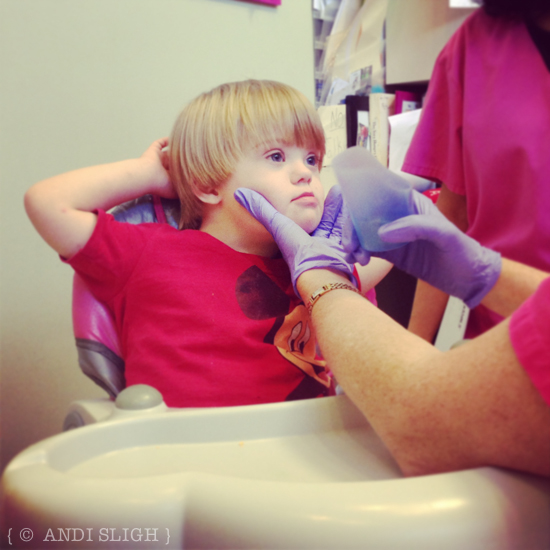After months and months of agonizing and second guessing and discussing, we decided to send Nathan to private speech therapy. He receives speech twice a week at his developmental preschool, but even though he has been making progress, it’s slow and tedious. I’m not sure what private therapy might do for him, but something needs to be done.
The thing is, he talks. A lot.
Even though he tends to be quiet at school, he’s a chatterbox at home. Sometimes he goes out in the backyard and talks to no one while gesturing wildly – he looks like a traveling evangelist preaching a hellfire-and-brimstone sermon to a sleepy congregation of grass. The problem with his sermons – and all of his other vocalizations – is that much of it is garbled and difficult to understand.
In short, what he’s been working on isn’t working.
As with many disciplines, multiple schools of thought exist about what is effective speech therapy. Some people adhere to a hardline perspective – “In order to improve speech you have to work on speech!” – which discounts any possible benefit from oral motor exercises.
Oral motor exercises are non-speech movements like blowing bubbles, chewing rubber tubing, sucking thick liquids through a straw, etc. The basic premise is that these actions form the foundation of all of the various sounds that are used in articulation. I’ll be the first to tell you that I have no idea if it’ll work. I’ve read opinions both for and against and I know what the evidential claims are.
I’ll readily admit that I’m not expert. I’m not a speech language pathologist and I don’t pretend to be. But I have watched Sarah Kate progress through physical therapy over the years and if a therapist had insisted she work on running before she learned to crawl, I would have wondered if we needed a new therapist.
So I went with my gut this time.
Eight years ago, selective dorsal rhizotomy (SDR) was only being performed in a few places and even fewer neurosurgeons had a lot of experience with the procedure. Fortunately, one of those more experienced doctors was only a short drive from where we lived, and after a bit of research, debate, and prayer we decided to go ahead with the procedure. Looking back, we (and “we” includes the doctors) can see that Sarah Kate was an ideal textbook case for SDR – it would have been a huge mistake to forego it. That decision was a lot tougher, because the risks were significant; blowing bubbles is unlikely to do Nathan any harm.


We put our daughter (3.5 years old) in ‘private’ speech therapy after we realized her 22 month old sister was more understandable. It was a wonderful decision. Her therapist’s approach combines speech/oral motor/feeding techniques including PROMPT, Beckman stretches, Talk Tools hierarchies, and many others. We learned she had dissociation and coordination issues. In the past months her speech and eating has improved significantly. She can now have conversations on the phone with her great-grandparents (and I don’t even need to translate when their conversation ends). Above all, it’s really helped her kndependence and self-esteem. Oh and tantrums.. They’re still there, but now they’re about not getting her way instead of not being understood.
Best wishes for success 🙂
Your daughter’s therapist’s approach sounds very much like what Nathan is getting. Do you mind telling me how soon you were able to see marked results? Nathan doesn’t throw tantrums, but I can see him struggle when we can’t understand him, and he seems to have confidence issues around other children. He’s a chatterbox at home and in his developmental preschool (he’s currently the only child in his class) but clams up in his private preschool where all of the other kids are typical and more advanced in his speech.
Over the 17 years my daughter with moderate cerebral palsy has been in therapy, we’ve made a few tough changes and choices. The toughest was last January when we decided to drop private therapies entirely. It felt downright wrong, but it was time. We weren’t seeing progress and had to come to the realzation that “what we saw was about what we were going get”. That doesn’t mean this is the end. We’ve just got to be more creative with her growth.
I understand where you’re coming from – I’ve begun thinking about when the “end of the road” will be for Sarah Kate. I believe she’ll need to continue with physical therapy until she stops growing, but for me that was in 8th grade, so I presume it will be the same for her. One of her early therapists who is now a family friend has always emphasized that activity is better than therapy, which is why we continue to press onward with softball and swim team. I’d like for her to try golf, since it’s something that wouldn’t be hard on her joints that she could do for the rest of her life.
I don’t think it can hurt to do it and if you have the money for it (or if insurance covers it). Reece did oral-motor exercises as part of her speech therapy when she was 3. She enjoyed it, we practiced at home, and I think it helped. Once she got her autism diagnosis, though, insurance stopped paying for any therapy, so we paid out of pocket while we could, and then we had to stop. I can still see evidence of weak muscles in her mouth and jaw (one of the reasons she gets lots of smoothies and milkshakes – drinking through straws helps LOL), so she probably could have continued, but her speech is nearly 100% intelligible now when she slows down enough! One thing we have done with some therapies that were questionable was to give it a fixed period of time (or amount of money) and at the end of that time, decide if we’d seen any quantifiable evidence that showed that it works for our situation, and then re-evaluate! The hard part with any therapy is knowing if it is the therapy that actually worked or if it would have happened anyway with the passing of time. Sometimes you just have to go with your gut.
Money is always an obstacle, of course. We are fortunate (if you can call it that) in that Sarah Kate missed several weeks of therapy early in the year due to Nathan’s on-again off-again illness and her request (which we tried for the summer) to go to every two weeks rather than every week – normally we run out of our allotted 30 visits by about September and have to start paying 100% out of pocket at that point. We’ve also already paid deductibles on both kids this year. Unfortunately, our portion is still 20% of each visit, and although I haven’t seen a statement yet the therapist gave me an estimate and it was hard to swallow. BUT…when Sarah Kate was the same age that Nathan is now, we took a leap of faith with the SDR (and the associated year of daily PT) not knowing how we would pay for it but knowing that it was essential. It was stressful and difficult, but in the end we survived and it was the right thing to do.